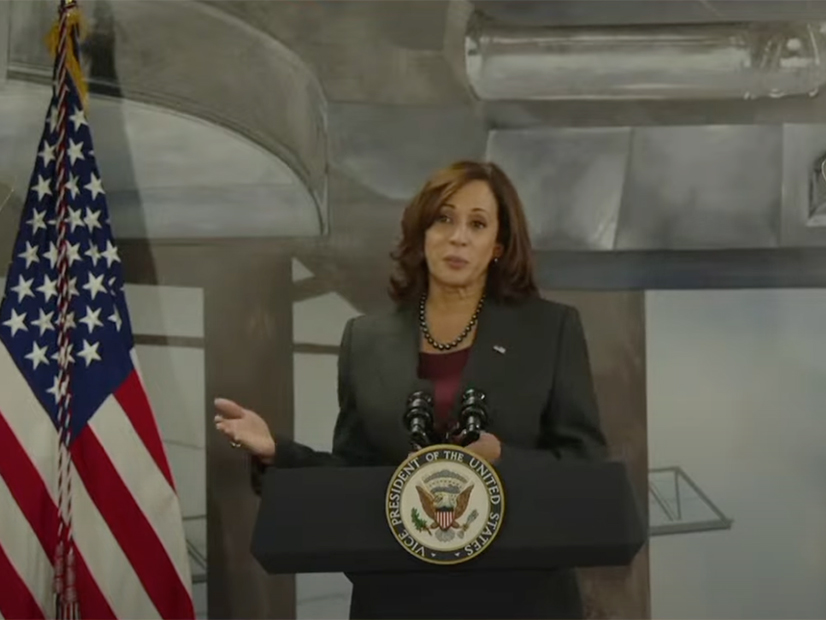
With winter heating bills on the way, the Biden administration on Wednesday announced nearly $9 billion in funding from the Inflation Reduction Act to provide rebates to families for upgrading their homes with a range of energy-efficient improvements.
Announcing the new funding to a cheering crowd at a Sheet Metal Workers Union hall in Boston. Vice President Kamala Harris said the $146 million coming to Massachusetts will provide “rebates of more than $800 per household to help families purchase and install, for example, a new electric stove and … up to $1,600 per household to help families install new insulation. It means giving families up to $8,000 to replace their gas furnace” with a heat pump.
The funding connects “so many important priorities by helping families pay the upfront cost for energy efficiency upgrades to their homes,” Harris said. “We are also lowering energy bills, bringing down household costs, creating jobs and fighting the climate crisis.”
The rebate program could help to upgrade up to 1.6 million homes nationwide and install up to 500,000 heat pumps, according to a White House fact sheet. Harris estimated the savings per household at $500 a year; the Department of Energy said savings nationwide could reach $1 billion annually.
The DOE announcement provided more details on the funding, along with a list of allocations going to the states, ranging from more than $690 million for Texas to $59.4 million for the District of Columbia. Another $225 million is earmarked for a “high efficiency home rebate program” for tribal communities.
But those savings will likely not come this winter. Wednesday’s announcement allows states to “access information about their allocated funding and … begin planning programs to distribute relief to families, using these funds,” according to the White House.
The DOE release laid out a series of steps that will be taken prior to any actual distribution of funds. A series of “listening sessions” with states and “a wide array of stakeholders” will be held over the next three months, followed by a request for information early in 2023. DOE is targeting spring 2023 for getting the money to the states, with the public receiving rebates later in the year.
“States will have greater resources to meet their consumers’ needs and more rapidly achieve home electrification on the path to a net-zero emissions economy,” Energy Secretary Jennifer Granholm said in the release.
The rebate program is aimed at helping moderate- and low-income families with the upfront costs of energy efficiency improvements, Harris said.
The Details
The funding is divided between two programs: one providing home energy performance-based rebates and a second with rebates for high-efficiency home electrification, according to DOE.
For the performance-based rebates, homes that reduce energy use by 20% will be eligible for $2,000 in rebates, while a 35% cut in energy use will qualify for up to $4,000 in rebates. Those maximums will double for retrofits for low- and moderate-income households.
The rebates available for a high-efficiency electric home top out at $14,000 per household, with a $8,000 cap for a heat pump and $1,750 for a heat pump water heater, with all rebates paid at point of sale. Electric stoves and clothes dryers will also be eligible for rebates, as well as insulation and sealing measures.
The high-efficiency home rebates will also be based on family income relative to an area’s median income. A family earning 80% to 150% of the median income would qualify for rebates covering 50% of the cost of a specific upgrade, while households earning 80% or less of the median would receive a 100% rebate.
RACER
DOE also announced on Wednesday $43 million in funding for 23 projects that will “help communities plan their transition to a clean energy future and improve grid reliability and security.”
Most of the money will go to 20 projects under the Renewables Advancing Community Energy Resilience (RACER) program, which DOE said “seeks to enable communities to utilize solar and solar-plus-storage solutions to prevent disruptions in power caused by extreme weather and other events.”
For example, the Virginia Department of Energy is receiving $1 million for a project that “will identify opportunities to use distributed energy resources like solar-plus-storage in 10 different locations [in Southwestern Virginia] to maximize the benefits of energy resiliency infrastructure for disaster response needs.”
According to figures from the National Oceanic and Atmospheric Administration, the U.S. has sustained 15 extreme weather events with losses exceeding $1 billion each. Total costs are estimated at $30 billion, with “significant economic effects on the areas impacted,” DOE said.
The other three projects will focus on “building tools to help communities better evaluate and benefit from local energy resources,” DOE said. “Researchers will develop and share planning methodologies, tools, technologies and best practices that can be replicated in communities across the country as they work to install clean energy and strengthen grid infrastructure.”
“Knowledge is power, especially when it comes to giving local communities the tools to understand and make informed decisions about their own energy supply and needs,” Granholm said. “These critical projects will help deliver reliable, affordable energy to every pocket of America — strengthening the safety and resiliency of communities across the nation.”


